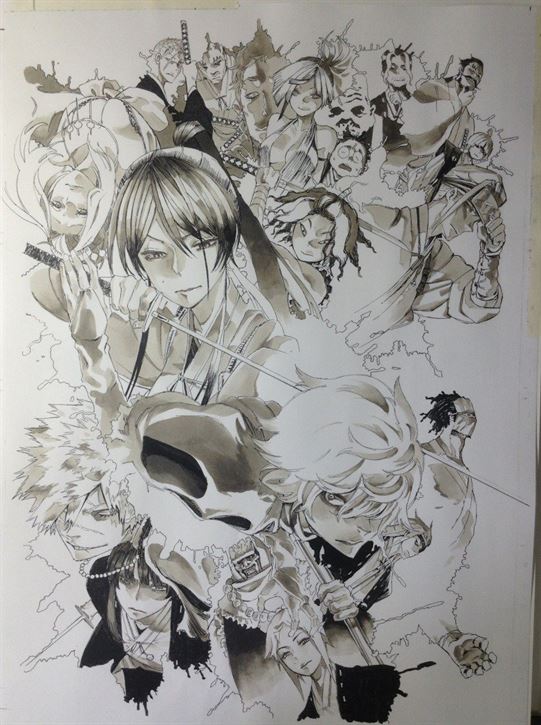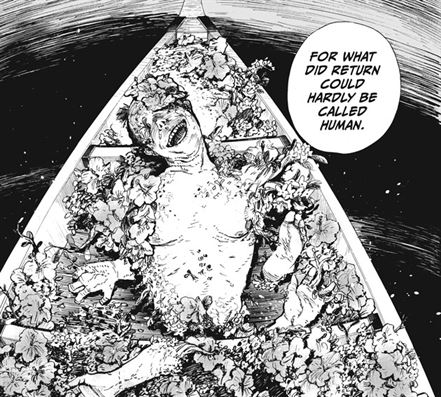A cast of morally questionable convicts and honor-bound executioners more loveable than baby animals, mystic fight scenes bordering on body horror, and a mystery as dangerously seductive as the setting itself, all packed into 13 volumes of a manga that’s nothing short of a masterpiece. Underneath the bloody exterior of Yuji Kaku’s “Hell’s Paradise: Jigokuraku,” is a story filled with heart and humanity, held up by a charming rogues’ gallery of characters and artwork gorgeous enough to frame.
Since “Hell’s Paradise: Jigokuraku” is manga, for those unaware, manga are comics originating from Japan, written and read right-to-left, top-to-bottom rather than the American left-to-right.
The plot follows a group of ten death row convicts in the Edo period of Japan, sent to a mysterious island believed to be paradise, with their assigned executioners to find a rumored elixir of immortality in exchange for a criminal pardon. Soon finding themselves in over their heads as they encounter the island’s monstrous guardians and eerie inhabitants, the characters must survive against each other and their new threat to have any hope of finding the elixir.
Gabimaru, our protagonist, is a vicious shinobi assassin who desperately seeks reunion with the one thing that makes him feel human, his wife, whose vital status and even existence are uncertain. Accompanying Gabimaru is Sagiri, his executioner, the lowest ranked member of her clan due to her hesitation to end a life and self-doubt.
Reluctantly forming some semblance of partnership, Gabimaru and Sagiri set out to overcome their supernatural environment and leave (hopefully) in one piece. Through trials and tribulations, we see the evolution of their dispositions as Gabimaru grapples with his humanity and Sagiri grapples with her wavering confidence.
Not only is the supporting cast equally as compelling as the protagonists, but they even manage to overshadow them at some points. Each pair of convict and executioner are given their own focus and time to shine in the story, giving depth and emotional attachment to them. Their originally separate paths often cross and overlap, making every character important to the narrative.
A handful of the supporting cast includes the brutish blade master Gantetsusai and dissection-obsessed Fuchi, the unfairly incriminated Nurugai and virtuous samurai Tenza, the femme fatale ninja Yuzuriha and meek bookworm Senta and last but certainly not least are the bandit king Chobei and his brother who worships him, Toma (my one true love).

The expansive cast of "Hell's Paradise: Jigokuraku."
Courtesy of @ug_kaku / Twitter
Kaku’s brilliant artwork extends into his eye for character design. Personality is on full display with every design, instantly conveying the central figure’s nature to the reader. Tenza proudly flaunts his shiny headband while Chobei’s tattered brigand rags echo his lifestyle of thievery. Going from viewing the concept art to seeing the character’s final forms, it’s undeniably clear that an immense amount of thought and detail was poured into all aspects of their designs, a sentiment that further brings them to life.
Stakes within the story are high and not every character is guaranteed to escape from the deadly conditions of the island. Having potential death around any corner for the protagonists creates an ever-present sense of tension, and gives way to some brutal and gory beatdowns as they desperately fight for their lives.
The semi-superhuman nature of the cast’s ruthlessly honed killing abilities lends itself perfectly to skirmishes with foes, human and inhuman alike. Battles often become slaughters, soaking each page with blood, guts and severed limbs. This hyper-violence is anything but tasteless though, as the grit and feel of real mortality add to the pressure of every struggle.

Yuji Kaku's beautifully haunting artwork.
Photo courtesy of Viz Media
Clashes have a weight of visceral horror that’s brought forth by the abominations fought against. The enemies themselves are just as unique as the key players, looking as if they were plucked straight from sleep paralysis. The nightmarish monstrosities may vary wildly in both size and appearance but they’re all ingeniously connected by a common design theme that ties into the island’s mystery, treating readers to a variety of creepy creatures.
While the adversaries are a pivotal part of world-building in “Hell’s Paradise: Jigokuraku,” the greater contributor is the setting itself. The island is overrun with colorful floral, disturbingly ethereal architecture, and vaguely religious imagery. Backgrounds tell a visual story and provide further clues for the isle’s history.
Everything feeds together and culminates into the series’s overarching theme of balance. From the oxymoronic title to the characters trying to adapt to their gruesome reality, Kaku continually pushes the notion of finding the middle ground between two extremes. Self-reflective and thought-provoking for the cast and readers alike, Kaku even interweaves this theme into the power system of the narrative, creating a dynamic where internal strength gives way to external.
“Hell’s Paradise: Jigokuraku” is an unforgettable rollercoaster that’ll have the reader riding the fine emotional line between hellish despair and blissful paradise. With the anime adaptation airing on April 1, there’s never been a better time to see what all the hype is about and jump into this masterwork of manga.



